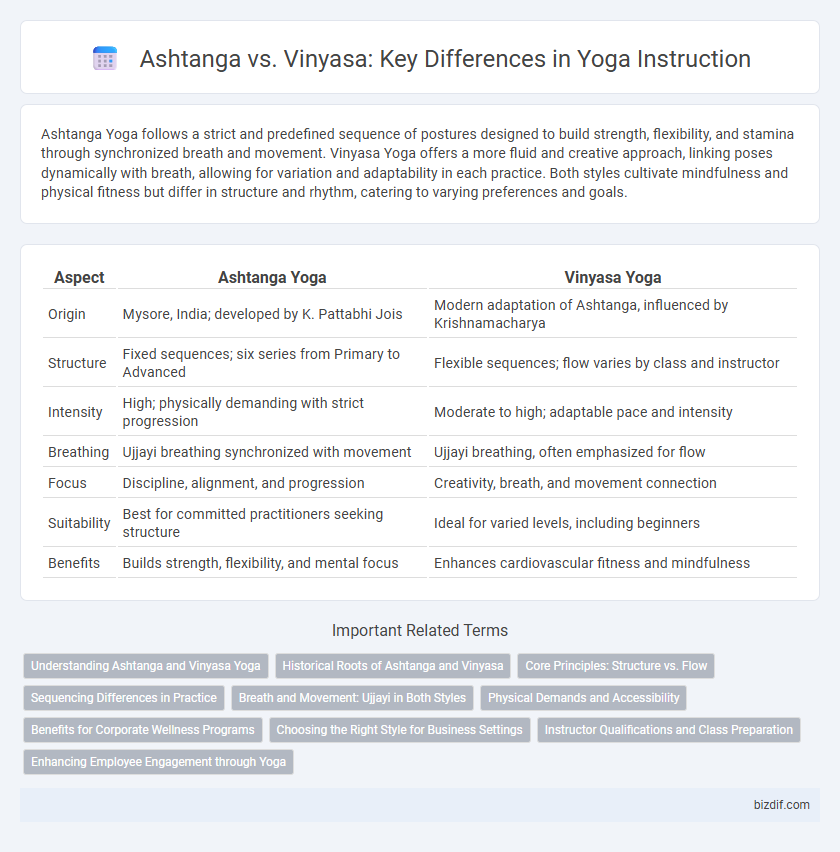Ashtanga Yoga follows a strict and predefined sequence of postures designed to build strength, flexibility, and stamina through synchronized breath and movement. Vinyasa Yoga offers a more fluid and creative approach, linking poses dynamically with breath, allowing for variation and adaptability in each practice. Both styles cultivate mindfulness and physical fitness but differ in structure and rhythm, catering to varying preferences and goals.
Table of Comparison
| Aspect | Ashtanga Yoga | Vinyasa Yoga |
|---|---|---|
| Origin | Mysore, India; developed by K. Pattabhi Jois | Modern adaptation of Ashtanga, influenced by Krishnamacharya |
| Structure | Fixed sequences; six series from Primary to Advanced | Flexible sequences; flow varies by class and instructor |
| Intensity | High; physically demanding with strict progression | Moderate to high; adaptable pace and intensity |
| Breathing | Ujjayi breathing synchronized with movement | Ujjayi breathing, often emphasized for flow |
| Focus | Discipline, alignment, and progression | Creativity, breath, and movement connection |
| Suitability | Best for committed practitioners seeking structure | Ideal for varied levels, including beginners |
| Benefits | Builds strength, flexibility, and mental focus | Enhances cardiovascular fitness and mindfulness |
Understanding Ashtanga and Vinyasa Yoga
Ashtanga Yoga follows a fixed sequence of postures linked by breath and movement, emphasizing disciplined practice and building strength through repetition. Vinyasa Yoga offers a more fluid, dynamic flow with variations tailored to individual needs, promoting creativity and adaptability. Both styles synchronize breath with movement but differ in structure and pacing, catering to diverse practitioner preferences.
Historical Roots of Ashtanga and Vinyasa
Ashtanga Yoga traces its historical roots to the teachings of T. Krishnamacharya in the early 20th century, deeply influenced by ancient Indian texts like the Yoga Korunta, emphasizing a fixed sequence of postures linked by breath. Vinyasa Yoga, while also derived from Krishnamacharya's lineage, evolved as a more flexible and creative flow practice, adapting sequences to suit individual styles and modern preferences. Both styles share foundational elements, yet Ashtanga maintains a traditional, structured approach whereas Vinyasa allows for variation and spontaneity in practice.
Core Principles: Structure vs. Flow
Ashtanga yoga emphasizes a fixed sequence of poses performed in a precise order, promoting discipline and consistency through its structured practice. Vinyasa yoga prioritizes fluid movement and breath synchronization, allowing for creative transitions and adaptability within each session. Both styles cultivate strength and flexibility, but Ashtanga's core principle is structure, while Vinyasa centers on flow and continuous motion.
Sequencing Differences in Practice
Ashtanga yoga follows a fixed, rigorous sequence of postures designed to be practiced in the same order, creating a disciplined flow that builds strength and flexibility systematically. Vinyasa yoga offers a more dynamic and flexible approach, allowing instructors to creatively sequence poses to suit different levels and styles, emphasizing breath-synchronized movement. The primary sequencing difference lies in Ashtanga's consistent repetition versus Vinyasa's adaptive variability, catering to diverse practitioner needs.
Breath and Movement: Ujjayi in Both Styles
Ujjayi breath, characterized by a soft, oceanic sound, synchronizes breath with movement in both Ashtanga and Vinyasa yoga practices. In Ashtanga, Ujjayi breath is integral to maintaining rhythm and intensity throughout fixed sequences, promoting internal heat and focus. Vinyasa incorporates Ujjayi breath fluidly with transitions, enabling dynamic flow and mindful pacing between poses.
Physical Demands and Accessibility
Ashtanga yoga involves a rigorous and structured sequence of poses performed in a specific order, demanding significant strength, flexibility, and cardiovascular endurance, making it more physically intense and less accessible for beginners or those with limited mobility. Vinyasa yoga offers a more fluid and adaptable practice, blending breath with movement in varied sequences that can be modified to accommodate different fitness levels and physical limitations, enhancing accessibility. Both styles promote strength and flexibility, but Vinyasa's versatility often makes it a more approachable choice for diverse practitioners.
Benefits for Corporate Wellness Programs
Ashtanga yoga enhances physical strength and mental focus through a structured sequence, making it ideal for corporate wellness programs aiming to boost employee discipline and stress management. Vinyasa yoga promotes flexibility and breath coordination with dynamic flow, supporting workplace creativity and cardiovascular health. Integrating both styles can improve overall employee well-being, reduce absenteeism, and foster a productive corporate environment.
Choosing the Right Style for Business Settings
Ashtanga yoga offers a structured, predictable sequence that appeals to businesses seeking consistency and measurable progress for employees, while Vinyasa yoga provides a dynamic, flow-based practice ideal for creative and flexible work environments. Selecting the right style depends on factors such as company culture, employee fitness levels, and desired class intensity. Incorporating feedback and assessing class engagement can ensure the chosen style maximizes wellness benefits and productivity in professional settings.
Instructor Qualifications and Class Preparation
Ashtanga yoga instructors typically require certification through a rigorous Mysore-style apprenticeship emphasizing precise sequencing and alignment, ensuring classes follow a structured, traditional format. Vinyasa instructors often hold certifications that emphasize adaptability and creative flow, allowing for tailored class preparations based on student needs and varying levels. Both styles demand thorough knowledge of anatomy and the ability to modify poses safely, but Ashtanga instructors prioritize consistency while Vinyasa teachers focus on dynamic sequencing.
Enhancing Employee Engagement through Yoga
Ashtanga yoga's structured sequence builds discipline and focus, improving mental clarity and reducing workplace stress, which enhances employee engagement. Vinyasa yoga's fluid and dynamic flow promotes creativity and adaptability, fostering team collaboration and energy. Incorporating both Ashtanga and Vinyasa practices into corporate wellness programs supports holistic employee well-being and sustained productivity.
Ashtanga vs Vinyasa Infographic

 bizdif.com
bizdif.com